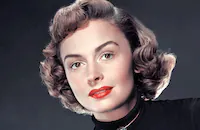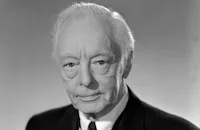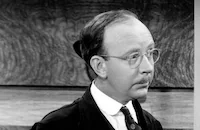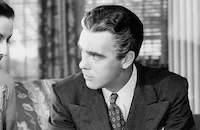Faithful in My Fashion

Brief Synopsis
Cast & Crew
Sidney Salkow
Donna Reed
Tom Drake
Edward Everett Horton
Spring Byington
Sig Ruman
Film Details
Technical Specs

Synopsis
Hoping to find everything just as he had left it four years ago, soldier Jeff Compton, who is home on a two-week furlough, visits the New York City department store in which he worked and surprises his former co-worker and sweetheart Jean Kendrick with a kiss. Jean, who is now an executive with the store, has since fallen out of love with Jeff, however, and is dating Walter Medcraft in the accounting department. As Jean never returned the engagement ring that Jeff sent to her while he was away, Jeff believes that she is still his fiancé. Realizing that Jeff is about to get his heart broken, Dilworthy and other department employees band together and, with Jean's consent, work diligently to prevent Jeff from learning the truth about his failed engagement. While Walter is out of town on business, Jean is temporarily assigned to the stock room to keep her away from the other store employees, who might reveal the truth. Jean tries to make the best of her temporary demotion while clumsily hiding her ineptitude at menial stockroom tasks, but trouble mounts when Jeff makes plans for an immediate wedding. After stalling Jeff's rush to marriage, Jean makes hasty arrangements to move back into her former, and more modest, West Tenth street apartment so that Jeff will not suspect that she become more successful. Professor Boris Riminoffsky, a music teacher and a romantic idealist who is currently living in Jean's old apartment, gladly gives up his apartment for two weeks when he learns that it will be done in the name of love. No sooner does Riminoffsky step out of his apartment than Jeff arrives ready to seduce his sweetheart. While Jeff plays a romantic tune for Jean on the piano, Riminoffsky and Dilworthy, who have been getting drunk in a bar, decide to help keep things moving along for the couple by returning to the apartment after Jeff and Jean leave and turning it into a "garden of Eden" honeymoon suite. Jeff, still with marriage on his mind, takes Jean for a drive up the coast to visit his great-grandfather and to present her with a gift. Soon after Jeff and Jean return to New York, Jeff visits Walter, who has returned from his trip. Jeff informs him that he plans to marry "Miss 916," and Walter is happy for Jeff until he realizes that "Miss 916" is Jean. When Jeff ducks out of Walter's office to buy Jean a wedding ring, Jean tells Walter the truth about her relationship with Jeff. Meanwhile, Jeff learns the truth about Jean and Walter from the jeweler, who has the ring that Walter ordered for Jean ready for delivery. Jeff is devastated by the revelation, but the situation is soon remedied when the department employs a new scheme to reunite Jeff and Jean, and Jean forsakes her relationship with Walter. The department staff, watching anxiously as Jeff and Jean are brought together in a store display, declare the couple "sold" when they profess their love for each other.

Director
Sidney Salkow
Cast

Donna Reed

Tom Drake

Edward Everett Horton

Spring Byington

Sig Ruman

Harry Davenport
Wm. "bill" Phillips

Margaret Hamilton

Hobart Cavanaugh

Warner Anderson

Connie Gilchrist
Fred Essler
Wilson Wood
Jack Overman
Marjorie Davies
Barbara Billingsley
Celia Travers
Leon Holmes
Pietro Sosso
Ruth Hilton
Phyllis Kennedy
Frank Johnson
Lillian Yarbo
Ned Winchester
Billy Newell
Gino Corrado
Edward Gargan
Teddy Infuhr
Bert Moorehouse
Dwayne Hickman
Tim Hawkins
Vincent Graeff
Fred Chapman
Gail Aronson
Henry Iblings
Earl Hunsaker
Thomas Clarke
Dudley Kuzzell
Crew
Fred E. Ahlert
Mac Alper
Charles J. Burbridge
Mark Davis
Peter P. Decker
Ralph Freed
Rudolf Friml
Cedric Gibbons
Lionel Houser
Lionel Houser
Irene
Harry Mcafee
Warren Newcombe
Gladys Norvell
Ralph A. Pender
David Ragin
George Richelavie
Arthur Rose
Charles Salerno Jr.
William J. Saracino
Douglas Shearer
Nathaniel Shilkret
Nathaniel Shilkret
Howard Shoup
Newell Sparks
William Steinkamp
Michael Steinore
Max Terr
Roy Turk
Irvine Warburton
Don T. Whitmer
Edwin B. Willis
Dolph Zimmer

Film Details
Technical Specs

Articles
Faithful in My Fashion - Faithful In My Fashion
In the romantic comedy Faithful in My Fashion (1946), Reed was the leading lady. She plays a department store executive whose fiancé comes home on a two-week furlough. While he's been at war, she not only has advanced in her career, she's fallen for another man. But co-workers persuade her to pretend that everything's the same as before so as not to spoil her fiancé's leave. She bumbles ineptly through a stockroom job, and moves back into her old, more modest apartment. Then, of course, the romantic meddlers conspire to keep the couple together.
A slight but appealing film, Faithful in My Fashion's biggest strength is the supporting cast of some of the top character actors of the era: dithering Edward Everett Horton, wise grandpa Harry Davenport, blustering Sig Ruman, fluttery Spring Byington, and no-nonsense Margaret Hamilton. The chemistry between Reed and Tom Drake, who plays the soldier, is also strong. Drake had become America's favorite boy next door when he played opposite Judy Garland in Meet Me in St. Louis (1944), and he played a similar charmer in Faithful in My Fashion. Reed got a chance to show her talent for comedy, a gift that had been little utilized so far, but would become an important part of her later career. In a May 1946 interview in Modern Screen magazine, Reed noted, "Why, it's the first time I've been able to laugh on the screen!" In typical style, Variety called Faithful in My Fashion a "Hokey story handled deadpan style with a thick spread of molasses...a fair sentimental item for the femmes," but had praise for the young stars: "Film showcases [Drake's] boyish charms to good advantage...Donna Reed makes an appealing heart interest."
Reed's next film would prove to be her breakout. She was loaned to producer-director Frank Capra to play Mary Hatch in It's a Wonderful Life (1946). Some sources say that MGM agreed to the loanout on the condition that Reed sign a new seven-year contract with the studio. Reed still had two years to go on her original contract, and she did leave the studio two years later, so it's unclear if a second contract was ever signed. At the time, however, Reed believed that It's a Wonderful Life would lead to better things at MGM: "It's amazing that I could have acted in so many B pictures as I did and still have ended up with It's a Wonderful Life. Since then, Metro has lined up lots of important roles for me!" That proved not to be the case. A similar thing happened after her Oscar®-winning role in From Here to Eternity (1953), when Columbia failed to follow up with important parts. Reed turned to television in 1958, starring in the sitcom The Donna Reed Show for eight seasons.
Producer: Lionel Houser
Director: Sidney Salkow
Screenplay: Lionel Houser
Cinematography: Charles Salerno
Art Direction: Cedric Gibbons, Harry McAfee
Music: Nathaniel Shilkret
Film Editing: Irvine Warburton
Cast: Donna Reed (Jean 'Chunky' Kendrick), Tom Drake (Jeff Compton), Edward Everett Horton (Hiram Dilworthy), Spring Byington (Miss Mary Swanson), Sig Ruman (Professor Boris Riminoffsky), Harry Davenport (Great Grandpa), William 'Bill' Phillips (1st Barfly), Margaret Hamilton (Miss Applegate), Hobart Cavanaugh (Mr. Wilson), Warner Anderson (Walter Medcraft).
BW-82m. Closed Captioning.
by Margarita Landazuri

Faithful in My Fashion - Faithful In My Fashion
Quotes
Trivia
Notes
This film marked writer Lionel Houser's first picture as a producer, and his onscreen credit reads: "Produced and written by Lionel Houser." While early Hollywood Reporter production charts list Arthur Rose as the film's assistant director, the Screen Achievements Bulletin and later production charts list Dolph Zimmer as the sole assistant director.















